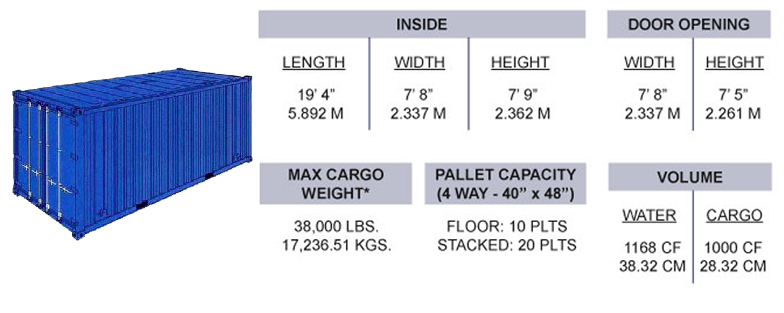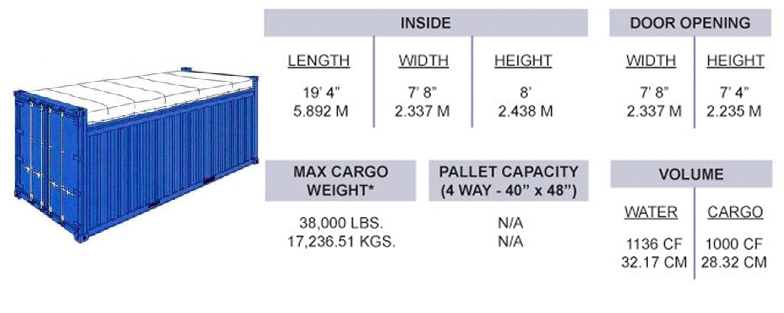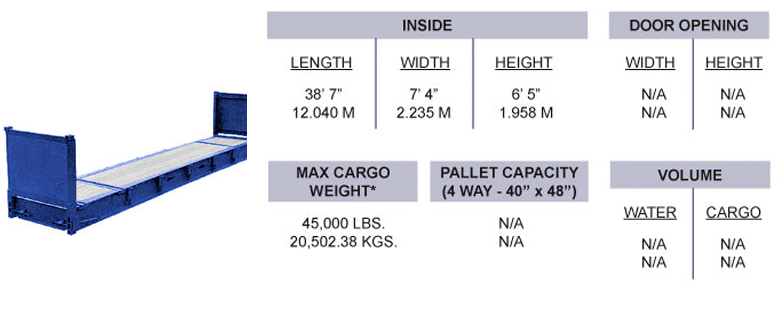20 ft. Dry/Standard

For all kinds of general cargo. General cargo should not be out of gauge or overweight. Most containers
are constructed of steel for sturdiness. Also may be manufactured from aluminum.
20 ft. Open Top

Open top containers do not have a solid roof. A weather proof tarpaulin is used, that can be secured with
ropes and cable sealing devices. Open tops are designed specially for over height (out of gauge) or bulky
cargo. The open top allows cargo, such as machinery, to be loaded with a crane. They are also equipped
with rings on the inside to secure cargo with straps for transit.
20 ft. Flat Rack

Flat racks are designed for out of gauge or heavy cargo that needs to be loaded from the side or top.
There are different types of flat racks, with variable structures. Some may have corner posts or walls,
that may or may not be collapsible. They are also equipped with rings on the inside to secure cargo with
straps for transit. All are manufactured from steel.
40 ft. Dry/Standard

For all kinds of general cargo. General cargo should not be out of gauge or over-weight. Most containers
are constructed of steel for sturdiness. Also may be manufactured from aluminum.
40 ft. High Cube

High cubes are able to hold more volume than dry/ standard containers. For all kinds of general cargo.
General cargo should not be out of gauge or overweight. Most containers are constructed of steel for
sturdiness. Also may be manufactured from aluminum.
40 ft. Open Top

Open top containers do not have a solid roof. A weather proof tarpaulin is used, that can be secured with
ropes and cable sealing devices. Open tops are designed specially for over height (out of gauge) or bulky cargo.
The open top allows cargo, such as machinery, to be loaded with a crane. They are also equipped with rings
on the inside to secure cargo with straps for transit.
40 ft. Flat Rack

Flat racks are designed for out of gauge or heavy cargo that needs to be loaded from the side or top.
There are different types of flat racks, with variable structures. Some may have corner posts or walls, that
may or may not be collapsible. They are also equipped with rings on
the inside to secure cargo with straps for transit. All are manufactured from steel.
40 ft. Refrigerated

“Refers” are designed for cargo that needs the temperature to be controlled at a specific, desired setting.
Refers have a refrigeration unit, with a generator, that are built into the nose of the container, and will
pump cold air into the bottom of the container. The unit will circulate the air, and is capable of reducing
carbon dioxide levels if produce is being transported in order to avoid cargo spoiling.
45 ft. Dry/Standard

45 ft. dry containers are able to hold more volume than dry/ standard and high cube containers. For all
kinds of general cargo. General cargo should not be out of gauge or over-weight. Most containers are
constructed of steel for sturdiness. Also may be manufactured from aluminum
*Be advised that the maximum payload weights listed above do not correspond to the manufactured limits.
Weight limits given are for road and rail transport.
**Containers carrying out of gauge, or oversized cargo are equipped with lashing devices which allow for secure
strapping and bracing of the cargo. Special permits are required for out of gauge cargo.